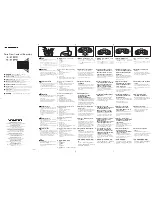
1) Levenhuk Nelson 7x50 model
Nelson 7x50 has three concentric circles of numbers on an objective tube. The inner circle represents the rangefinder scale reading. The outer
circle of number represents the distance. The circle of numbers in between represents the object size.
Turn the rotatable zone of the plate and stop when the arrow points to the number of the rangefinder reading. If you already know the object
size, find the number of the object size on the plate, and the corresponding number of the outer circle is the distance to the object. If you already
know the distance, find the number of distance on the plate, and the corresponding number of the middle circle is the object size.
Example: To determine the distance to an object you must first know its size (height). Look at it and measure the image height on the reticule.
A building reaches to 3.9 on the scale (fig. 4). Turn the scale ring until the white mark points to 3.9 on the upper scale (A, fig. 5). The lower scale
on the ring is the object size. Here, the number 12 (B, fig. 5) stands for the known height of the tower and is exactly below the number 400
(C, fig. 5) on the distance scale. Therefore, the building is 400m away from you.
When you know the distance to the object, you can determine its size (height).
Example: The building is 300m away from you. Look at it and measure the image height on the reticle. It reaches to 3.9 on the vertical scale.
Now turn the scale ring until the white triangle points to 3.9 on the upper scale. Over “300” on the distance scale is the number 9 on the object
size scale. The building height is therefore 9m.
2) Levenhuk Nelson 8x30 model
For Nelson 8x30, you can use formulas to calculate the distance to the object (when you know its size) or the object’s size (when you know the
distance.)
When you know the object’s size (in centimeters), calculate the distance to the object (in meters):
Example: Object size (you know) is 51cm, rangefinder scale reading is 1.7 units. Calculate the distance to the object: 100 × 51 / 1.7 = 3000m.
When you know the distance to the object, calculate the object size (height):
Example: Distance (you know) is 3000m, rangefinder scale reading is 1.7 units. Calculate the object height: 3000 × 1.7 / 100 = 51cm.
Fig. 5
A
B
C
Size =
Distance =
100
rangefinder scale reading
distance × rangefinder scale reading
100 × size
1
2
140
200
300 400
600
3
4
5
6 7 8 9 10
12 14
16
0·4
0·8
0·6
0·3
50 60
70 80
100
1·2
1·6
2·5
2
3























